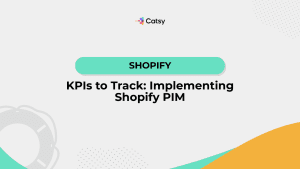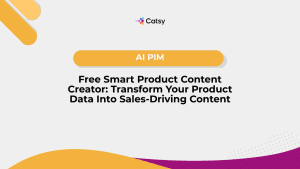Open Source vs SaaS PIM: Which Product Information Management System Is Right for You?
So, you’re thinking about getting a Product Information Management system, aka a PIM? Picking the right one can really set your business up for smooth scaling, especially if you’re in ecommerce or B2B.
But, surprise, there’s not just one kind. You’ve got to choose between open source and SaaS (that’s Software as a Service).

What even is a PIM system?
Alright, picture this. You’ve got product info all over the place, spreadsheets, emails, and your website backend. Chaos. A PIM system pulls all that together. One clean, organized spot. That way, everything, your product descriptions, images, and pricing, is consistent everywhere: your site, Amazon, catalogs, you name it.
Some cool features most PIMs have:
- One central place for all your data
- Tools to make your info look better (like adding specs or media)
- Storage for your images and videos (aka Digital Asset Management or DAM)
- Ways to share info with different sales channels
- Automation to save you time
In this Article
Open Source PIM: What’s the deal?
Open source is kind of like getting a blank canvas, but for your product data. You will get full access to the source code. That is great, as you or your tech team can tweak, build, and customize it to fit your exact needs. It allows you to be in complete control.It doesn’t matter if it’s creating custom workflows, integrating with niche tools, or adapting the UI to match your team’s preferences. Pretty neat, right? This is especially powerful for businesses that have unique product structures or workflows that out-of-the-box SaaS solutions just can’t handle.
Why do people love open source?
One word: control. With open-source PIM, you’re the boss of everything. You get to decide how it looks, how it works, and how it fits into your current systems. No limitations, no waiting on a vendor to release that one feature you desperately need. If you’ve got the technical know-how (or a solid IT team), the possibilities are basically endless. Want to add a custom product attribute field? Go for it. Need to integrate with a homegrown ERP? You can make it happen.
Customization is another huge win. Think of it as your digital playground, you’re not stuck with someone else’s idea of what a PIM should be. You can build unique workflows, automate data imports and exports, and even design your own UI if you’re feeling fancy. Plus, there are no recurring fees. Once you’ve set things up and found a hosting provider, your costs drop significantly. That can be a big bonus for companies looking to keep long-term expenses low.
But… the tricky stuff?
Well, freedom comes with responsibility. You’ll definitely need IT experts, this isn’t something you can just install and forget. Setting up the system, managing updates, troubleshooting bugs, and making sure everything stays secure? That’s all on your plate. And while many open source platforms have community forums or documentation, actual customer support usually only comes with the paid enterprise version. So if you hit a wall, you might be stuck unless you’ve got devs on hand.
Then there’s maintenance and security. Unlike SaaS solutions that take care of patches and compliance, with open source, you’re the one in charge of protecting your data. That includes keeping software up to date, securing your servers, and ensuring the system doesn’t break when new technologies roll out. It can be a lot, especially if your business is moving fast.
Make Catsy DAM and PIM Software an Extension of Your Team
Book a Free DemoSaaS PIM: Let someone else do the heavy lifting
Now, if you’re like, “Umm… I just want it to work.” SaaS PIM might be your jam. It’s cloud-based, which means a vendor handles everything, including hosting, updates, and support.
Some examples? Think Catsy, Plytix, or Salsify.
Why is it awesome?
SaaS PIM is basically the “set it and forget it” option. That is a huge win if you’re short on time or tech skills. But what is one of the biggest perks? Those who used Saas PIM would say that it’s super quick to set up. You can often be up and running in a matter of days (sometimes even hours). That allows you to start organizing your product data and syncing it across channels almost immediately. You will skip that annoying part of waiting for months for development or configurations.
Another great thing is that it also comes with a low upfront cost. This definitely makes it a smart choice for startups or smaller teams. You don’t need to use a chunk of cash for servers or custom development. All you need to do is just pay a monthly or annual fee. The annual fee typically includes everything: hosting, support, updates, and security.
And speaking of updates, you don’t need to worry about missing out on the new updates, as you’ll always be on the latest version. That means no manual upgrades, no downtime, and no stressing over whether your PIM is falling behind. New features? They just appear. Bug fixes? Handled in the background. It’s seamless.
Best of all, you don’t need to worry about servers, infrastructure, or tech bugs. The SaaS provider takes care of all the backend stuff, so you can focus on what matters: your products, your team, and growing your business. No late-night calls to IT. No patching vulnerabilities. Just smooth sailing.
Not-so-awesome parts?
- Less freedom to change things
- Monthly/annual subscriptions
- Your data lives on their servers
Let’s compare the two side by side
When it comes to hosting, open-source PIMs are self-hosted, meaning you’re in charge of where and how they run. SaaS PIMs, on the other hand, are cloud-based, with no servers to worry about. Customization is where open source really shines. It’s super flexible, letting you tweak pretty much anything. SaaS solutions are more limited in that area, but still give you a decent amount of control.
If you’re thinking about IT support, know this: open source definitely needs a tech-savvy team. SaaS? Not so much, you can usually get by without dedicated IT. Cost-wise, open source might hit your budget upfront (setup, hosting, dev time), but after that, it’s fairly low-cost to maintain.
SaaS runs on a subscription model, so you’ll pay as you go. In terms of scalability, open source gives you the tools, but you have to build it yourself. SaaS comes ready to scale. Finally, security: with open source, it’s all on you to keep things safe. With SaaS, your provider handles security and compliance for you.
So, flexibility vs. scalability: what matters more to you?
If you’ve got a very specific way of doing things or need tons of customization, go open source. But if you want to grow fast without tech headaches, SaaS is probably the way to go.
Let’s talk security. With open source, you’re the boss. But you’re also the IT guy, the security guard, and the fix-it person. Not ideal if you’re not super technical.
SaaS PIM, on the other hand, usually comes with all the bells and whistles, SOC 2, GDPR, ISO standards, you name it. So, if you care about compliance or just don’t want to deal with cyber stuff, SaaS is way easier.
What about support and updates?
Let’s be real, support and updates can make or break your experience with a PIM. With open source, you’re flying solo. That means you or your IT team are responsible for everything, from patching bugs and troubleshooting errors to managing downtime and keeping the system running smoothly. If something breaks, there’s no vendor hotline to call. You either fix it yourself or hire someone who can. It gives you total control, sure, but also full responsibility.
On the flip side, SaaS PIM makes life a whole lot easier. You get built-in support, so if anything goes wrong, you can just open a support ticket or live chat with someone who actually knows the system inside and out. Updates? Automatic. Security patches? Done in the background. System performance? Monitored 24/7. Basically, they handle all the messy backend stuff so you can focus on growing your business, not babysitting software.
Now, the money part
Let’s talk dollars. With Open Source, the software itself is usually free to download and use, no licensing fees, which sounds great at first. But keep in mind: you’ll still have to pay for IT help (either in-house or outsourced), servers or cloud hosting, ongoing maintenance, and any support you might need down the line. Those costs can sneak up on you.
With SaaS, you pay a monthly or annual subscription fee, but that price typically includes the whole package, hosting, tech support, automatic updates, and even top-notch security. It’s more of a “done-for-you” model, which means fewer surprises and way less stress. Especially if you’re a small team or don’t have dedicated IT resources, that predictability can be a game-changer.
For small brands or startups? SaaS gives you more bang for your buck upfront. Big companies with tech teams? They might save money long-term with open source.
How fast can you launch?
SaaS = days or weeks. Open source = maybe months, depending on how complex your setup is.
So, who should choose what?
So, what kind of business should go with which PIM? If you’re a startup or a small-to-medium brand, a SaaS PIM is usually your best bet; it’s fast, easy, and doesn’t require a big tech team.
Big enterprises that already have in-house IT experts might prefer open source because it gives them more control and flexibility. For B2B distributors, it really depends on how complex your product data is and how much customization you need.
Fast-growing brands often lean toward SaaS since it scales effortlessly and lets them move quickly. But if you’re in a highly regulated industry where control and compliance are a big deal, open source might be the smarter choice.
Still not sure? Here’s how to decide.
Ask yourself:
- Do I have an IT team or not?
- Do I need super custom features?
- Is speed more important than control?
- What’s my budget like?
- Do I need to follow strict compliance rules?
Here’s what I think: if you’re tight on time and want a plug-and-play experience, go with something like Catsy. But if your team loves tinkering with tech and you’ve got specific needs, open source could be worth the effort.
In the end… It’s all about what works for you:
- SaaS = Easy, scalable, fast
- Open Source = Flexible, customizable, full control
Whichever you go with, having a solid PIM setup is key to growing your business without drowning in messy data.
Want to see what a SaaS PIM like Catsy can do for you? Let’s chat, book a free consultation!
Want more tips, tutorials, and insights on product content and e-commerce operations?
Stay connected. We post regularly to help brands like yours scale smarter.
Are You Ready To streamline your product content management?
Continue Reading

Frequently Asked Questions
A PIM (Product Information Management) system centralizes all your product data, descriptions, images, pricing, and more into one place. It ensures your information stays consistent across all sales channels, saving you time and preventing costly errors.
Open source PIMs are self-hosted and highly customizable but require IT support to manage. SaaS PIMs are cloud-based, easier to set up, and maintained by the vendor, making them ideal if you want less technical hassle.
For startups and small businesses, SaaS PIMs are usually better due to their quick setup, low upfront cost, and vendor-managed support, allowing you to focus on growing your business.
Yes, open source PIMs require IT expertise for installation, customization, security, and maintenance. Without a technical team, it can be challenging to manage.
Open source PIMs are generally free to use but come with costs for hosting, IT, and maintenance. SaaS PIMs charge monthly or annual subscription fees, which cover hosting, support, and updates.
Absolutely! SaaS PIMs come with built-in scalability, so they grow with your business without the need for extra infrastructure or technical adjustments.
With open source, you’re responsible for security and compliance, which requires expertise. SaaS providers handle security measures and certifications, often providing stronger, out-of-the-box protection.
Subscribe For More Content
Sign up for monthly tips on how to drive revenue with product content.




